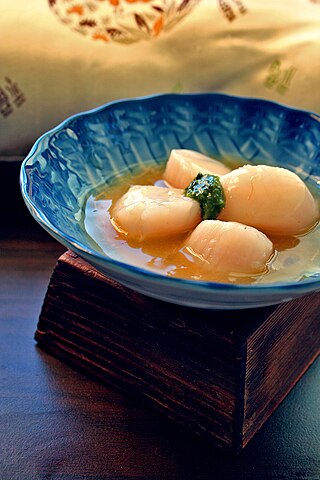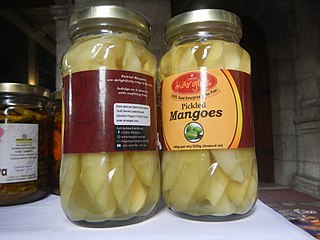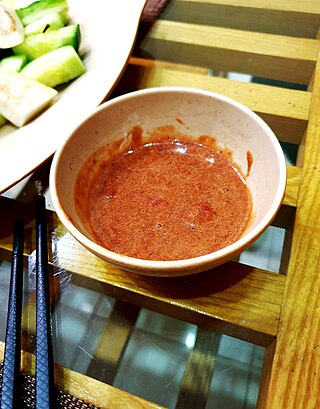
Lactic acid fermentation is a metabolic process by which glucose or other six-carbon sugars are converted into cellular energy and the metabolite lactate, which is lactic acid in solution. It is an anaerobic fermentation reaction that occurs in some bacteria and animal cells, such as muscle cells.

Conpoy or dried scallop is a type of Cantonese dried seafood product that is made from the adductor muscle of scallops. The smell of conpoy is marine, pungent, and reminiscent of certain salt-cured meats. Its taste is rich in umami due to its high content of various free amino acids, such as glycine, alanine, and glutamic acid. It is also rich in nucleic acids such as inosinic acid, amino acid byproducts such as taurine, and minerals, such as calcium and zinc.

Bagoóng is a Philippine condiment partially or completely made of either fermented fish or krill or shrimp paste with salt. The fermentation process also produces fish sauce known as patís.

The history of sushi began with paddy fields, where fish was fermented with vinegar, salt and rice, after which the rice was discarded. The earliest form of the dish, today referred to as narezushi, was created in Japan around the Yayoi period. In the Muromachi period (1336–1573), people began to eat the rice as well as the fish. During the Edo period (1603–1867), vinegar rather than fermented rice began to be used. The dish has become a form of food strongly associated with Japanese culture.

Fermented fish is a traditional preservation of fish. Before refrigeration, canning and other modern preservation techniques became available, fermenting was an important preservation method. Fish rapidly spoils, or goes rotten, unless some method is applied to stop the bacteria that produce the spoilage. Fermentation is a method which attacks the ability of microbials to spoil fish. It does this by making the fish muscle more acidic; bacteria usually cease multiplying when the pH drops below 4.5.

Tempoyak, asam durian or pekasam is a Malay condiment made from fermented durian. It is usually consumed by the ethnic Malays in Maritime Southeast Asia, notably in Indonesia and Malaysia. Tempoyak is made by taking the flesh of durian and mixing it with some salt and kept in room temperature for three or five days for fermentation. Tempoyaks are usually made during the durian season, when the abundance of durian and excess production are made into fermented tempoyak.

Burong mangga is a Filipino side dish made by mixing sugar, salt, and water to mangoes that have previously been salted. The mixture of water and sugar should be boiled and cooled first, before pouring it over the salted mangoes. Some variants add chilis to the cooled sugar water mixture. Original "basic" burong mangga is made using a brine solution and pouring it over halved unripe or partially ripe mangoes. Mango cultivars commonly used for burong mangga include 'Carabao' mangoes and 'Pico' mangoes.

Shrimp paste or prawn sauce is a fermented condiment commonly used in Southeast Asian and Southern Chinese cuisines. It is primarily made from finely crushed shrimp or krill mixed with salt, and then fermented for several weeks. They are either sold in their wet form or are sun-dried and either cut into rectangular blocks or sold in bulk. It is an essential ingredient in many curries, sauces and sambal. Shrimp paste can be found in many meals in Cambodia, Indonesia, Laos, Malaysia, Myanmar, the Philippines, Singapore, Thailand, and Vietnam. It is often an ingredient in dip for fish or vegetables.

The generic term for condiments in the Filipino cuisine is sawsawan. Unlike sauces in other Southeast Asian regions, most sawsawan are not prepared beforehand, but are assembled on the table according to the preferences of the diner.

In food processing, fermentation is the conversion of carbohydrates to alcohol or organic acids using microorganisms—yeasts or bacteria—under anaerobic (oxygen-free) conditions. Fermentation usually implies that the action of microorganisms is desired. The science of fermentation is known as zymology or zymurgy.

Tapai is a traditional fermented preparation of rice or other starchy foods, and is found throughout much of Southeast Asia, especially in Austronesian cultures, and parts of East Asia. It refers to both the alcoholic paste and the alcoholic beverage derived from it. It has a sweet or sour taste and can be eaten as is, as ingredients for traditional recipes, or fermented further to make rice wine. Tapai is traditionally made with white rice or glutinous rice, but can also be made from a variety of carbohydrate sources, including cassava and potatoes. Fermentation is performed by a variety of moulds including Aspergillus oryzae, Rhizopus oryzae, Amylomyces rouxii or Mucor species, and yeasts including Saccharomyces cerevisiae, and Saccharomycopsis fibuliger, Endomycopsis burtonii and others, along with bacteria.

Pla ra, similar to padaek in Laos, is a traditional Thai seasoning produced by fermenting fish with rice bran or roasted rice flour and salt fermented in a closed container for at least six months. Fermented fish seasoning are commonly found in Cambodian, Lao, Mon, Thai and Vietnamese cuisine. Pla ra has a very strong smell, which is considered unpleasant by some people. Its flavors are salty and sour, depending on the amount of salt put in and lactic acid resulting from fermentation process.

Cincalok is a Malay condiment that originated in Malacca, Malaysia, consumed by Malays, Peranakans and Kristangs. Its origins can be traced back to the Portuguese occupation of Malacca. This condiment consists of fermented small shrimp or krill, which are called udang geragau in Melaka and are easily identifiable in the mixture. It is predominantly salty in taste, and is usually served together with chillis, shallots and lime juice. Sir R. O. Winstedt has written about "Cencaluk" in Malaysia in his book "The Circumstances of Malay Life - 1909". This shrimp is seasonally available in Pantai Klebang, Limbongan, Tanjung Kling and several coastal areas.

Mắm nêm is a sauce made of fermented fish. Unlike the more familiar nước mắm, mắm nêm is powerfully pungent, similar to shrimp paste. Many of the regions that produce fish sauce, for example Central Vietnam, also produce mắm nêm. It is commonly mixed with sugar, pineapple, and spices to make a prepared sauce called mắm nêm pha sẵn, the key ingredient in neem sauce.

Naem is a pork sausage in Lao and Thai cuisine. It is a fermented food that has a sour flavor. It has a short shelf life, and is often eaten in raw form after the fermentation process has occurred. It is a popular Southeast Asian food, and different regions of Southeast Asia have various preferred flavors, including variations of sour and spicy. Naem is used as an ingredient in various dishes and is also served as a side dish.

Burong isda is a Filipino dish consisting of cooked rice and raw filleted fish fermented with salt and angkak for around a week. The dish is common in central Luzon, most notably in the province of Pampanga. Angkak may also be omitted, especially in western central Luzon, resulting in a white-colored version. Burong isda variants are usually named after the fish they were made with; e.g. burong bangus for burong isda made with bangus (milkfish). Shrimp versions of the dish are known as burong hipon or balao-balao. Burong isda is very similar to other fermented fish and rice dishes of Asia, including narezushi of Japanese cuisine and pla ra of Thai cuisine. All of these dishes rely on lactic acid fermentation to preserve the food.

Tinapayan is a Filipino dish consisting of tapay and dried fish. It originates from the Maguindanao people. It is very similar to the more widespread northern dish burong isda, but differs in that the fish is dried first.

Pekasam, Pakasam or Bekasam is a Malay term for fermented food, more precisely fermented fish product. In Malay and Banjar cookery, pekasam usually refers to freshwater fish fermented with salt, palm sugar, toasted rice grains and pieces of asam gelugur.
Dayok is a Philippine condiment originating from the islands of Visayas and Mindanao in the Philippines. It is made from fish entrails, excluding the heart and the bile sac. It is fermented with salt, and sometimes rice wine (pangasi) and various herbs. It has a sharp umami and salty flavor very similar to patis and bagoong. They are sold in sealed glass bottles.




















